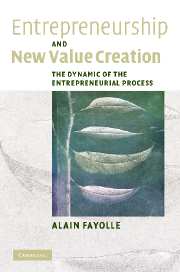Book contents
- Frontmatter
- Contents
- List of figures
- List of tables
- Foreword
- Acknowledgements
- Introduction
- Part I Perceptions of entrepreneurship
- Part II Entrepreneurship and the entrepreneurial system
- 4 A new perspective to understand entrepreneurship
- 5 Individual dimension in the I↔NVC dialogic
- 6 New value creation dimension in the I↔NVC dialogic
- Part III Entrepreneurship and entrepreneurial processes
- Part IV Entrepreneurial process dynamics
- Conclusion
- References
- Index
5 - Individual dimension in the I↔NVC dialogic
Published online by Cambridge University Press: 22 September 2009
- Frontmatter
- Contents
- List of figures
- List of tables
- Foreword
- Acknowledgements
- Introduction
- Part I Perceptions of entrepreneurship
- Part II Entrepreneurship and the entrepreneurial system
- 4 A new perspective to understand entrepreneurship
- 5 Individual dimension in the I↔NVC dialogic
- 6 New value creation dimension in the I↔NVC dialogic
- Part III Entrepreneurship and entrepreneurial processes
- Part IV Entrepreneurial process dynamics
- Conclusion
- References
- Index
Summary
The main thesis I wish to develop in this chapter is that there are no born entrepreneurs, but that individuals become entrepreneurs in situations they have desired or are subjected to. They become entrepreneurs through a learning process thanks to which they acquire know-how and personal skills at various levels. Drucker (1985) clearly emphasised this point: ‘The entrepreneurial mystique? It's not magic, it's not mysterious, and it has nothing to do with the genes. It's a discipline. And, like any discipline, it can be learned.’ Admittedly, not all the aspects of entrepreneurship can be taught and acquired, but, for a number of years now, teachers and professionals have given up the idea of a born entrepreneur (Kuratko 2005). Shapero (1984: 28) confirmed this in one of his contributions:
I have said nothing of the psychology of entrepreneurs. It is not by over-sight. The more I study entrepreneurs, the more I am impressed by the great variety of kinds of people who are entrepreneurs, and the more I find it difficult to be satisfied with simple psychological profiles. Entrepreneurs are not born, they are developed. The great majority of people are capable of being made more entrepreneurial.
Individuals first acknowledge the possibility of the entrepreneurial act (and process) owing to changes in perception and behaviour that in turn lead to the emergence of the entrepreneurial intention. The process evolves through changes in perception that modify what we call the perceived instantaneous strategic configuration of the actor.
- Type
- Chapter
- Information
- Entrepreneurship and New Value CreationThe Dynamic of the Entrepreneurial Process, pp. 84 - 98Publisher: Cambridge University PressPrint publication year: 2007

